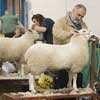Scottish red meat industry faces long road to recovery

Grave concern about the long-term lack of profitability of the Scottish red meat industry dominated ringside banter at the Scottish Winter Fair at Ingliston this week.
Alistair Donaldson, Scottish Association of Meat Wholesalers executive manager, told FWi that, even with some progress this week on the export front, there was still a long road to recovery.
“It is still very early days. The reality is we are in a global market which is very competitive and the issue is how do we stay competitive with high production costs?” said Mr Donaldson. Among the costs hitting the UK red meat sector were, he said, meat inspection costs and BSE control costs.
Feed costs were also hitting the Scottish beef sector particularly hard, he said, with some northern producers housing cattle for seven months, compared with global competitors in a better position to make the most of grazed grass.
During a Question Time panel session, concern about the contraction of the beef herd and loss of critical mass was raised. John Bell of the Scottish Beef Cattle Association pointed out the full impact of the contraction of Scottish suckler cows numbers would not be felt for two to three years due to the long beef production cycle.
Jack Clark, president of the Institute of Auctioneers in Scotland, said this October average prices for feeding cattle were about £50/head lower than last year.
“There are indications that there will not be the number of cattle bought to feed for the pure and simple reason there are not the numbers of cattle in the country now,” said Mr Clark.
And George Milne, Scottish Secretary of the National Sheep Association, also voiced concern about the decline in ewe numbers, down 18% in the past five or six years.
The question of forward contracts for red meat purchase also proved controversial, with some producers believing any certainty of price would be a step forward, while others – with an eye on this year’s grain contracts – were less convinced.
